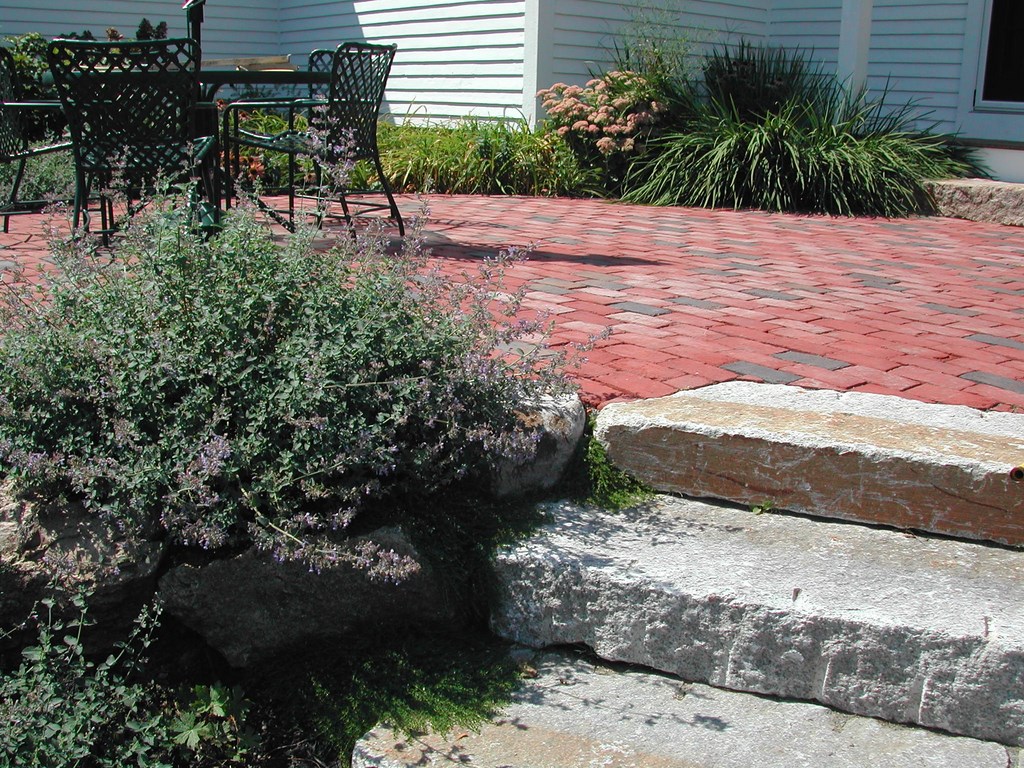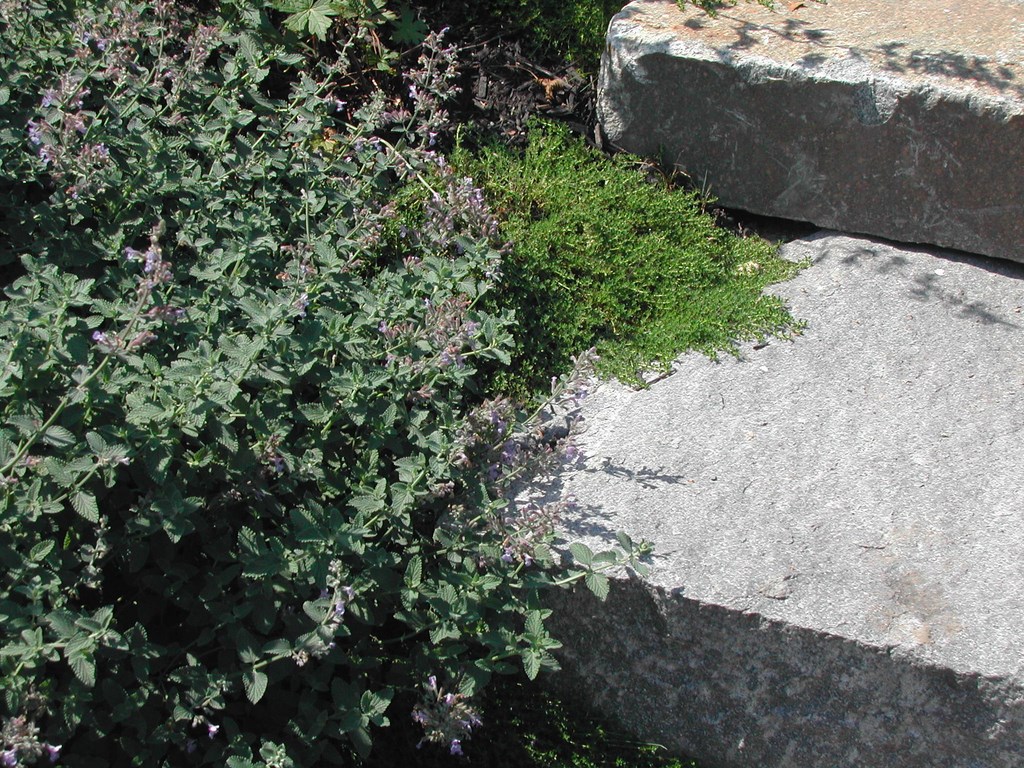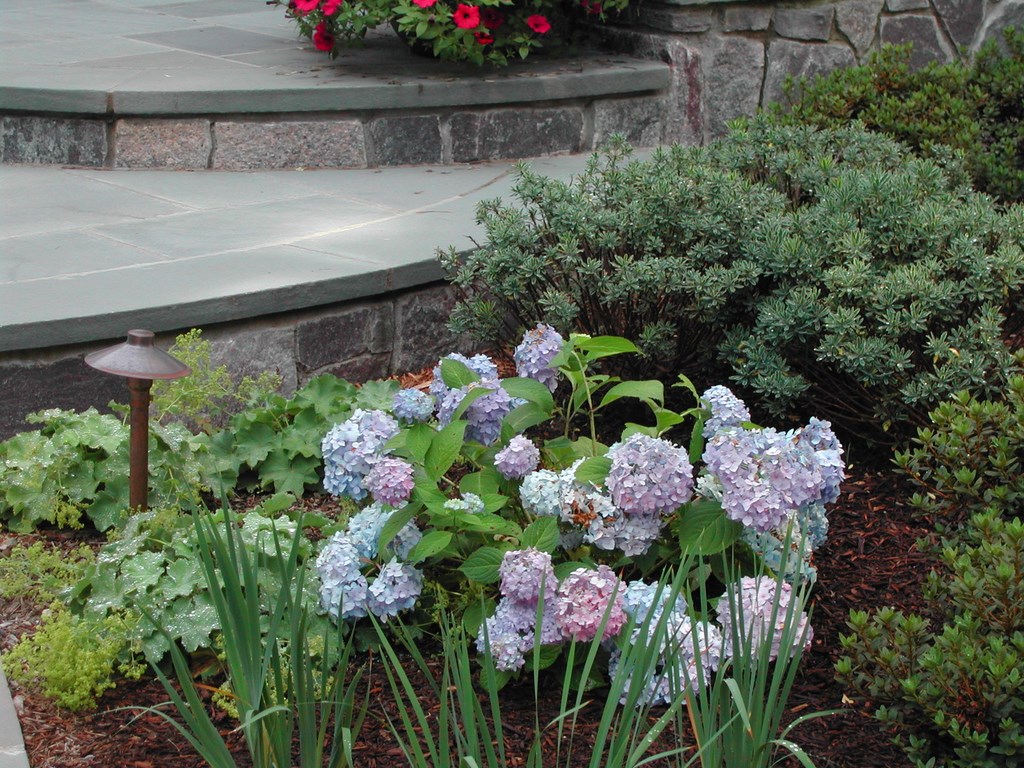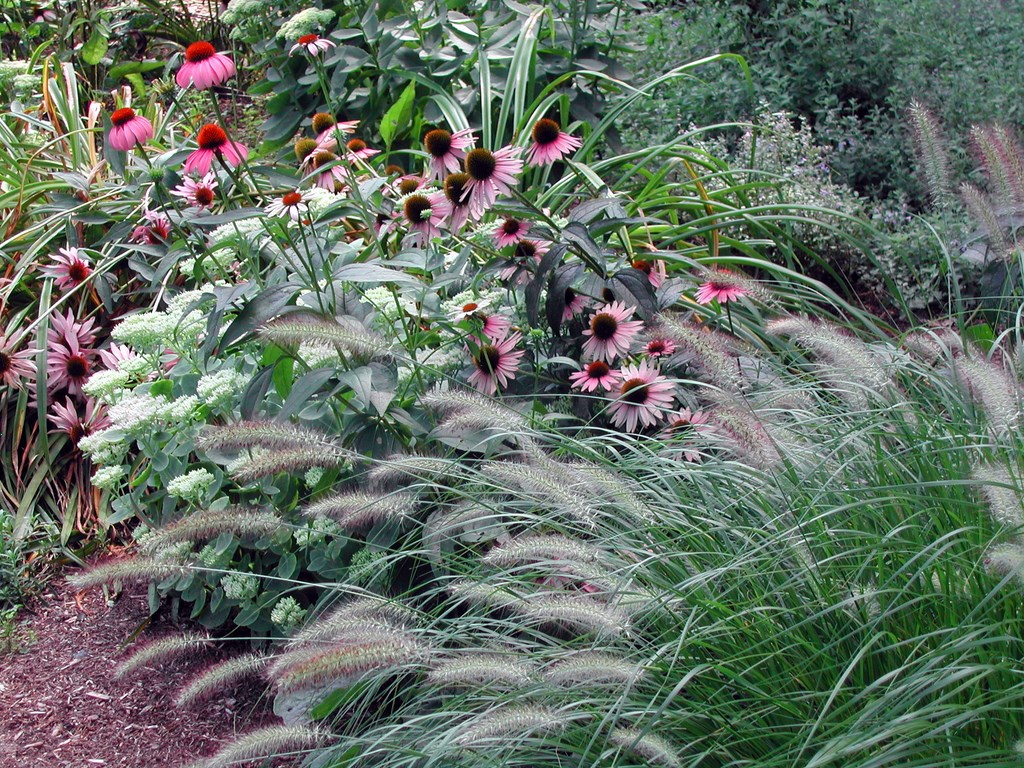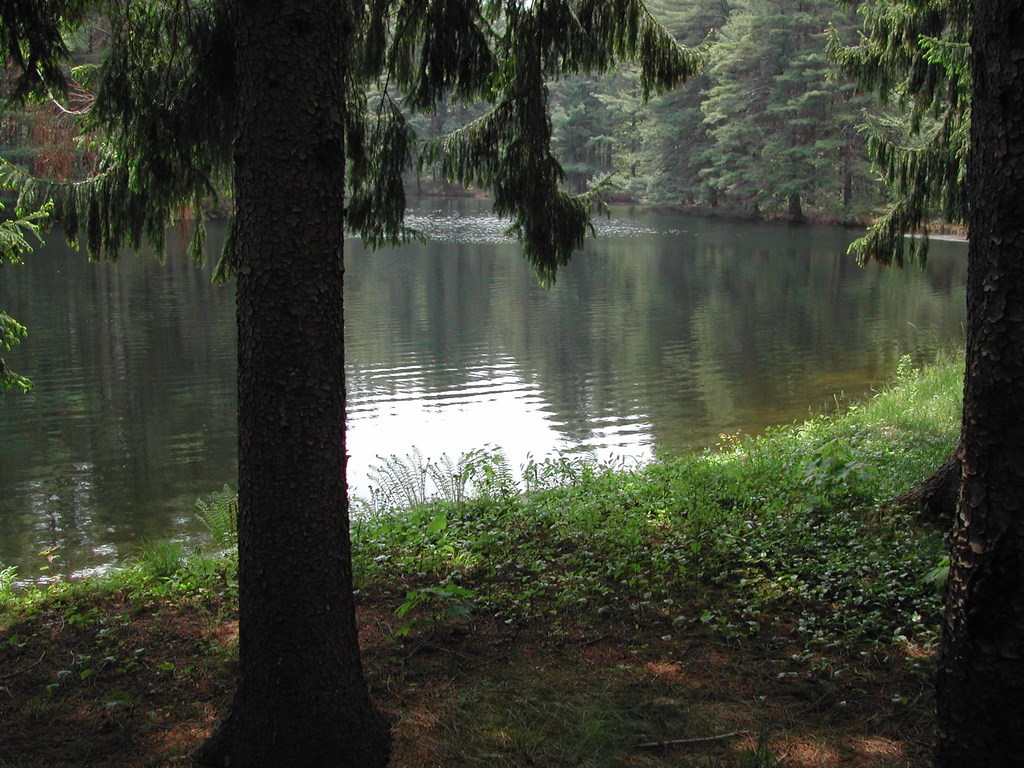Texture’s Magic
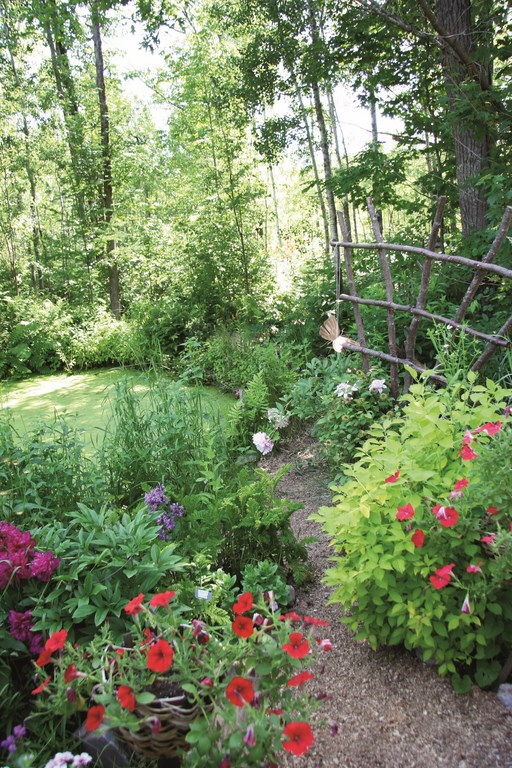
As is true of many things we savor in our lives, our perception of texture is filled with subtlety and nuance.
This is particularly true in gardens, where space, form, color and texture dance together to create our experience of a living entity and, for designers and installers, of the envisioned entity as well: We start by defining the entity’s function and style – make it an outdoor room, a neoclassical knot garden or a meditative space – then layer hardscape and plant materials to engage the five senses one by one or all at once.
Texture plays a large role in creating this sensory engagement: It’s the lure that invites observers to pause and linger, to breathe deep and compose themselves within the environment. In that sense, texture is the twin of form and the companion to color in the triad of basic garden relationships.
Texture also involves an artful tuning – a delicate weighting of diversity and unity to create the energy or enchantment a garden can enable. With too much texture comes chaos; with too little, boredom. When balanced properly, however, texture creates diversity and, repeated effectively, becomes a unifying factor.
DEFINING TERMS
Let’s start with the textbook definition of texture as “a pattern, coarse or fine, seen or felt, created by edges of repeated forms, or formed by an abrupt transition between color and reflections.”
Pulling that definition apart, let’s start by examining the phrase, “pattern, coarse or fine, seen or felt” and at Figure 1: Look at the old granite steps and the new “antique” bricks (that is, new material made using authentic, textured molds): It’s easy to imagine what it would feel like to run your hand over these surfaces and imagine the tactile sensations provided by these hardscape materials.
| Figure 1 |
Now examine the plants, looking first to the back toward the mass of Iris sibirica with its blade-like foliage juxtaposed against the flowering Sedum ‘Autumn Joy’ while the mass of Nepeta ‘Six Hills Giant’ spills over the rock holding the bank. These plants, combined with the chair’s webbing and the siding of the house, are all tactile images we can readily interpret.
Next, the definition speaks of texture as being created by “edges of repeated forms” – in Figure 1, this includes the edges of the bricks and granite (with grooves revealing the colonial cutting method) combined with the edges of the Iris blades, Sedum heads and Nepeta. This is all about the play between light and dark and how the shadows created by these forms define them so that we can see, identify and differentiate one form from another.
The ability to identify and differentiate is probably a deep-seated mechanism that once helped us to avoid tripping as we ran to avoid being overtaken by some predator. Now, it’s simply the mechanism by which we see different patterns – a skill that opens us up to a rich palette of sensory experiences in natural places.
Of course, not all natural places we happen upon are beautiful. A nearby pine forest I explored last winter was bare, uniform and without much differentiation, for example, whereas another one I visited weeks later held a diversity of textures – layers of trunks, twigs, rocks, grasses and reed plants with wooden bridges crossing streams and brilliant water reflections. This was a rich experience – a winter wonderland compared to the frozen wasteland I’d seen earlier.
Now take another look at the garden in Figure 1: Imagine the terrace floor as a flat plane without the bricks or any joints at all. Now picture the plants as simple outlined forms without the detail that texture adds – and do the same with the furniture, the light fixture and the home’s siding. It all appears plain and two dimensional, even though there’s still a suggestion of texture with the edges of the forms.
Remove the shadows or outlines and you’re left with emptiness – nothing at all, especially if you imagined the areas without color. In other words, texture is a detail that conjures more than a sense of richness: It’s actually at the heart of our sensory experience of the world around us.
A CLOSER VIEW
Now that we’ve looked at texture from a distance, let’s take a closer look at the same garden. In the overall view, we saw the contribution of the Nepeta, Thymus and granite to the room’s composition. But from far away, we probably didn’t notice the layered connection between the granite and the Nepeta (Figure 2).
| Figure 2 |
Climbing the irregular steps, we’d probably be watching our feet, at which point we’d be more likely to notice the tiny, spreading, velvety, silvery leaves of the Thymus contrasting with the larger silver Nepeta and the coarse texture of the granite. Obviously, scale plays a big role here, but even in the photograph, you can see the contribution texture makes to the way the details work visually and to the overall impression the garden makes.
Turning attention to Figure 3, look at the textural components of hardscape (the granite riser, the Bluestone treads of the circular landing and softscape (Daphne ‘Carol Mackie,’ Hydrangea ‘Early Summer,’ Alchemilla mollis and Iris sibirica).
The fine, tight texture of the Daphne contrasts with the smooth, loose textures of the Hydrangea flower, which in turn contrasts with its own flat, narrow, pointed leaves and the small, round, wavy leaves of the Alchemilla.
| Figure 3 |
The upright blades of the Iris play an effective role as well, providing contrast and interest. I particularly love the way Alchemilla leaves gather dew and raindrops, thus contributing another layer to the textural composition along with a compact element of reflection.
It’s helpful to consider all these different textures and how they might be used both to reveal each other and keep any one element from getting lost in the crowd. To name just a few possibilities, think about pairing shiny and coarse, flat and fleshy, fine with coarse, bold and feathery or lacy, spiky with intricate – or dense and airy against large-mass, bold leaves.
Then there is texture’s yin/yang relationship with form and how it helps to differentiate plants of similar cool tones, as seen in Figure 3 in the repeating shapes of the round Daphne leaf clump, the rounded Hydrangea flower composed of smaller flowers, the round leaf of the Alchemilla and the upright contrast of the Iris. Texture is clearly revealed where shiny, reflective leaves are paired with soft, furry, non-reflective ones.
| Figure 4 |
In Figure 4 we find a completely different textural combination, with the soft, furry Pennisetum inflorescence and its fine, reflective, bladed foliage contrasting beautifully with the bold, fleshy Echinacea flower and upright linear stems set against the tight Sedum ‘Autumn Joy’ flower buds, Hemerocallis’ wider-bladed foliage and the small but dense abundance of Nepeta ‘Six Hills Giant.’
Color is used here to draw attention to wondrous nuance, but not without help: It is the combination of texture and color, working in synergy to emphasize the visual attraction.
Finally, Figure 5 (below) helps us complete the definition with the phrase indicating that texture is “formed by an abrupt transition between color and reflections.” Here, the transitional area along the bank clearly emphasizes the ferns’ texture while its edge defines a visual pattern.
APPLYING TEXTURE
When it comes to using texture as a design tool, the Chinese proverb “Show the large in the small and the small in the large” certainly applies: We should use patterns architecturally – that is, on a large scale – and then again on a small scale in individual plant combinations.
Large-scale use of the same texture strengthens and complements that particular element. A huge mass of ferns with, for example, one single fern standing apart and alone is a powerful use of a textural mass. Or a wide swath of furry lamb’s ear edging a curving bed of spiky, coarse, feathery or toothed plants ties things all together and moves the eye around a bend into another garden space while defining the wall of an outdoor room.
| Figure 5 |
A meandering river of Daffodils flowing through a garden makes an effective textural contrast to emerging Hostas and Astilbes, but the effect wouldn’t work nearly as well if you used grasses or Daylilies – that is, plants with the same foliage texture – instead of the Daffodils. In that specific context, there’s the additional fact that the meandering contour would only be seen when the Daffodils were in flower. (Of course, depending upon your objectives, that might be perfect!)
Repetition of a thematic texture is another great tool, whether it involves plants, hardscape or accessories. Repeated appearances provide an opportunity to create a rhythm, a subtle way to move the eye, a bold technique for uniting garden areas and an effective way to create the impression of abundance and fullness. Flowering masses repeated throughout the garden are seen together because of the way the eye connects the color over a wide area.
And don’t forget the textures of sound, movement and fragrance! Grasses respond to wind, leaves rustle, water ripples and gravel crunches, weaving an aural texture throughout the garden space. Layered and repeated fragrances are undeniably seductive, and I try always to incorporate edible plants, including cherry tomatoes or blueberries that might invite someone to nibble.
The great thing is that all of this just scratches the surface: There are endless ways to play with textures and use them to engage the senses, provide delight and reveal the rich potentialities of our sensory experiences.
Maria von Brincken, APLD, owns and operates a full-service landscape design practice in Sudbury, Mass. Her award winning work has been published in Fine Gardening and is featured in Front Yard Idea Book (Taunton Press). She serves on the New England regional chapter board of APLD She has also been interviewed and quoted by national newspapers, has appeared on local television and gives lectures at garden clubs, symposiums and conferences. She can be reached at [email protected].











